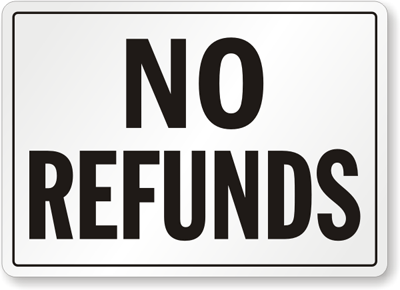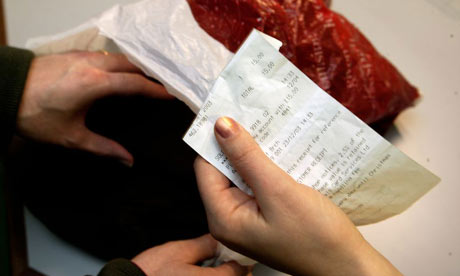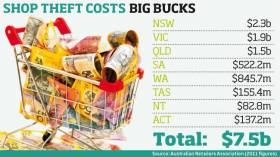Retail Musings
"How can money be the root of all evil, when shopping is the cure for all sadness..." Elizabeth Taylor

According to the fourth annual snapshot of Australian social media habits, retailers are driving the growth in social media marketing among small and medium sized businesses. Half of small - medium sized retailers are now using social media to drive business, up from just 32% in 2013. The rise is the biggest leap of any sector.
The full article is from Inside Retail and can be read here.
Why the leap? Because they are getting the picture: consumers are spending more of their time on social networks than ever. Combine that with the slew of new social ad formats Facebook and Twitter have introduced—many of which retailers say are very effective—and retailers see the results in big growth in traffic and sales that stem from social networks.

You're incredibly busy and someone asks to have a product gift-wrapped.
I've heard:
"Sorry, I can't do that today. We're too busy".
"You'll have to wait until I've finished serving these other customers".
"Not today. Sorry".
Or, the wrapping is poorly done with an equally poor attitude. Mind you, I've also seen perfectionists take an extraordinarily long time wrapping a gift whilst other customers 'silently fume'...

Don't believe everything you hear. Just because the press says the economy is sliding downward doesn't mean your sales will be affected. Your mental mindset plays a tremendous role in your success.
While it is difficult to maintain a positive perspective during times like this, it is essential to keep focused on your main objective. Associate with positive, like-minded people and avoid 'doom + gloomers' like the plague!

Definition: "a disposition to feel that anything less than perfect is unacceptable."
I recently spoke at a gathering about perfectionism. About half the room were prepared to admit that they were perfectionists. Initially.
Perfectionists are hard people to live with. Whether they're a friend, a family member, a business colleague, anyone at all. Why? Because nothing is ever good enough. It could have been done better... if you'd just done abc...if I'd just had more time I could've etc etc. They're just as tough on themselves as they are on everyone else mind you. It leads to a miserable life.
Don't get me wrong - I have nothing against striving. Striving to: do well; be a good friend; do the best possible job; to attain goals; to do better.

Consider shopping. Many women enjoy doing it, seeing it as a form of entertainment or a social experience shared with like-minded, well, women. Men, on the other hand "tend to not enjoy the same shopping experience as a woman."
To get them to go shopping in the first place and then engage them in the experience you have to be able to communicate more directly to them. No doubt you’ve heard the saying: “Treat others the way you’d like to be treated”. Some of us even try to live by this rule. However, when it comes to selling – it is sooo wrong. It should actually read “treat others the way they’d like to be treated”. And this is particularly true when it is a saleswoman selling to a man or a salesman selling to a woman.
Male and female brains are different in important ways that affect our attitudes and behaviours. Men and women typically communicate differently. For example, scientists tell us that women communicate four times more than men, ie. talk more, more verbal, more chatty.

Retailing is about selling. Everything we do is about having customers purchase merchandise from us.
We make our shops look nice so that customers will buy more merchandise.
We advertise so that more customers will buy.
We promote so that more customers will buy.
But if we do everything right - we have the best displays, the best location, the best advertising, the best promotions, the best merchandise, at the lowest possible price - and a staff member ignores or insults a customer - it's all for nothing.
Successful retailing depends on positive contact between the customer and staff. Think of selling as providing a service. After all, that's what your customers want.
 Think back to the last time you went on holiday. Chances are you didn’t visit a big box store for leisure. Instead, I’m willing to bet you strolled down a quaint street and wandered into boutiques and cozy little cafes. I’m also willing to bet that while doing that you felt relaxed and happy.
Think back to the last time you went on holiday. Chances are you didn’t visit a big box store for leisure. Instead, I’m willing to bet you strolled down a quaint street and wandered into boutiques and cozy little cafes. I’m also willing to bet that while doing that you felt relaxed and happy.
Now think about your own neighbourhood with the local store where the owner knows your kids by name. Again, I’m willing to bet that this business contributes to your happiness and quality of life. Small and independent businesses have a cascading effect on cities and towns—each small business is part of a total business network. When a big box moves in, a number of small businesses move out and you wind up seeing town centres or shopping strips gutted.
 Where goods are sold as seconds, customers may still be entitled to a refund. Just by stating that something is a second or broken does not remove the right to a customer receiving a refund. They cannot claim a refund on the fault that was drawn to their attention at the time of the sale, or if they change their mind about the purchase, but if other faults occur in the product, other than the original fault, they are again entitled to a refund.
Where goods are sold as seconds, customers may still be entitled to a refund. Just by stating that something is a second or broken does not remove the right to a customer receiving a refund. They cannot claim a refund on the fault that was drawn to their attention at the time of the sale, or if they change their mind about the purchase, but if other faults occur in the product, other than the original fault, they are again entitled to a refund.
Example A:
Say, for instance, a handbag is reduced and sold as a second because it was dirty.
If the handle of the handbag breaks, within reasonable time of use, then the customer is entitled to a refund.
The handbag was reduced because it was dirty, not because of a faulty handle.
 Retailers don’t have to use signs which enunciate their policy regarding refunds/returns, but if they are to be used, then they must clearly state what customers are entitled to. The signs don’t have to be long and complicated – shorter signs can be used as long as they don’t mislead the customer. However, disclaimers printed in small type can be considered as misleading, as customers may not see them.
Retailers don’t have to use signs which enunciate their policy regarding refunds/returns, but if they are to be used, then they must clearly state what customers are entitled to. The signs don’t have to be long and complicated – shorter signs can be used as long as they don’t mislead the customer. However, disclaimers printed in small type can be considered as misleading, as customers may not see them.
Signs which enunciate the refund/return policy of a retailer should be positioned as close as physically possible to the entrance(s) to the store. This way, the customer is unable to enter the store and make his or her purchases without having been deemed to be in possession of knowledge of the retailers refund policy.
 When you are dealing with customers and refunds, it is best to be cool and calm at all times [easier said than done on occasion]. When a loud-voiced customer comes into your shop demanding a refund, even though legally they are not entitled to one, try and deal with the situation rationally and calmly.
When you are dealing with customers and refunds, it is best to be cool and calm at all times [easier said than done on occasion]. When a loud-voiced customer comes into your shop demanding a refund, even though legally they are not entitled to one, try and deal with the situation rationally and calmly.
Why? Because statistics show that a happy customer will become a loyal customer. These days retailing is becoming more and more competitive and trying to build up loyal customers is probably the hardest part. But, if you succeed it will be worthwhile in the end.
It is always a good investment to have all staff trained on your service standards and how to handle customer complaints as customers don’t want to be bandied from one person to another to another. Ideally, they’d like the first person they approach to fix the problem.
One of the slideshows I presented to a industry association and its members
I crowd-sourced these answers from customers across facebook and twitter. These were the constants. Anything else you'd care to add?

You might want to put these ideas into action:
1. Raise Security Awareness with all staff. Ensure they work the salesfloor (where the thieves hang out) and are not stuck solely behind the counter! Good customer service is the key. Approaching someone with " Is there something I can help you with? I couldn't help but notice your interest in our sunglasses/lipsticks/shoes/shirts/tops etc etc... Perhaps I could show you a colour/size/demonstration etc etc?" Opportunistic shoplifters HATE being singled out and tend to leave your store rather fast. Which, after all, is exactly what we want them to do!

The buying function plays a critical role in a retail business because it is buyers who determine virtually all of the elements of the merchandise offer. If the buyer fails to get the ‘five rights’ (that is, merchandise, quantity, price, place and timing) right, no amount of slick presentation or promotion will save the retailer.
The effectiveness of the buying function has a major impact on the retailer’s ultimate profitability because:
- Merchandise is the principal generator of revenue
- Merchandise typically represents between 33 and 66 percent of a retailer’s total assets.
Viewed in this context, it becomes clear that buyers don’t simply acquire merchandise; they are in fact managers of money. Every decision they make has an impact on the company’s level of turnover, its profits, its cash flow and its return on investment.

Word of Caution (or Don’t Be “That Person”)
You know those people who go to networking events and try to sell you long before they learn anything about your needs? Who are pushing their product or service as they give you their never-let-go-G.I.-Joe-with-the-Kung-Fu-grip handshake? It’s easy in real life to see how obnoxious that behaviour is, right?
Well, then don’t behave that way on facebook. (Or on any social media site, for that matter.) Anyone jumping into social media as a way to make a quick sale will be sorely disappointed, and may irrevocably damage their reputation.
Social media is about building relationships; you build your network and your reputation over time by providing value to other people. The best book ever written on social media marketing could well be How to Win Friends and Influence People by Dale Carnegie.
Remember; You need to focus on building rapport, reaching out to connect with others, adding value, sharing information relative to your niche and marketplace.
Whenever there is a new type of technology, media or fad of any kind everyone hops on the new wagon. The foolish think just because it's new, the seat on the new wagon must be better. They think it will cost less, be easier, bring more customers. It's normal to look for a solution.
To hope that something will fix the issues that keeps you up at night. It is normal to hope and dream of the day you can go to sleep without waking up in the middle of the night to solve a problem.
Many do the same thing with social media.
They think once they are on Twitter, have a facebook page, and get everything automated their business problems will be solved. Sorry to break the news to you but that’s not how it works.
The reality is that social media will probably highlight these issues even further. It may even shine like a strobe light on the very broken areas of your business. It may put departments, people and even individuals under pressure. Why? Because you will be forced to talk about these things. Why? Because it is now more out in the open.

Too many small business people spend inordinate amounts of time and money trying to increase their profitability by attracting new customers, when all along they’re allowing a goldmine of profits to slip by right under their nose.
What is a Bump?
On each and every transaction you have the opportunity to increase your margins dramatically with a simple “bump” or “up-sell”. Bumps are offers made at the point of sale by giving a simple suggestion.
For instance, when I’m on the road, one of the easiest places for breakfast is McDonalds. I always order a Sausage Muffin and a flat white and each time I go to order, the counter person asks me if I’d like to have the large coffee. Errr, yeeesssss. This is a good example of a bump.

Remember: ALWAYS talk on purpose.
Purpose: resolution, a thing intended
The Australian Concise Oxford Dictionary
Experience doesn’t necessarily teach anyone anything. It can mean a repetition of mistakes.
What we need to do is make a deeper study of the relationship between the buyer and the salesperson.
Many salespeople have proudly announced that they have been paid a handsome compliment by a customer. ‘Do you know what they said? They told me I was the best salesperson who had called on them that week!” In fact, this was an indirect criticism, for the salesperson must have made it obvious to the customer that they were making an effort to take an order; and this is the worst form of salesmanship.
Selling has been called the gentle art of giving other people your own way. That sums it up pretty well.
High pressure selling is usually fraudulent selling, and an aggressive salesperson gets nowhere with a professional buyer. Nevertheless, a salesperson must be determined to obtain an order, although the determination mustn’t show.

“What’s the point of training my staff? I no sooner train them and they leave.”
So many times, this is the lament I hear from retailers. My answer is always the same:
“Your choice is to train them and run the risk of them leaving, or NOT training them and run the risk of them staying…..”
As a store, you’re either getting better or getting worse and in order to succeed, you need a store that is clean, well organised, properly merchandised and with salespeople who are trained well and WANT to sell.
I hasten to add, though, training for the sake of training – with no means of measurement – is a waste of time and money. What is the point of spending time training people if you don’t measure the improvement in your business?
The only reason to ever do sales training is to improve a sales statistic.
Let’s assume you have a store that is ready to sell. The product is displayed beautifully, the store is organised and as clean as can be. All the elements are in place for you to really sell and expand the business. The key element missing is: SALESPEOPLE.

It’s a funny thing, the decisions you make and where they take you. Never ever in a million years did I think I would “sell” anything.
The thought of selling was anathema to me ... and yet my first job was in a retail business (administration area NOT selling), I worked for a while in a legal firm – billing out hours (but never considering it “selling”), worked on ministerial staff in Federal politics but again never considered anything we did “selling”, and so it went until one day a friend of mine needed my help.
He asked me to help him sell some products he believed in.
I was nearly sick.
Because the “selling” involved standing up in front of people and “selling” his product.









